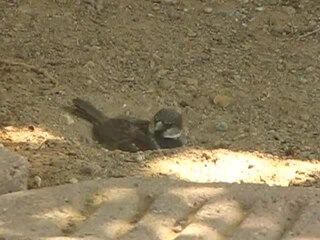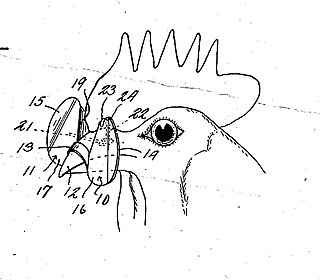
Debeaking, beak trimming, or beak conditioning is the partial removal of the beak of poultry, especially layer hens and turkeys although it may also be performed on quail and ducks. Most commonly, the beak is shortened permanently, although regrowth can occur. The trimmed lower beak is somewhat longer than the upper beak. A similar but separate practice, usually performed by an avian veterinarian or an experienced birdkeeper, involves clipping, filing or sanding the beaks of captive birds for health purposes – in order to correct or temporarily to alleviate overgrowths or deformities and better allow the bird to go about its normal feeding and preening activities. Amongst raptor-keepers, this practice is commonly known as "coping".

Free-range eggs are eggs produced from birds that may be permitted outdoors. The term "free-range" may be used differently depending on the country and the relevant laws, and is not regulated in many areas.

Free range denotes a method of farming husbandry where the animals, for at least part of the day, can roam freely outdoors, rather than being confined in an enclosure for 24 hours each day. On many farms, the outdoors ranging area is fenced, thereby technically making this an enclosure, however, free range systems usually offer the opportunity for the extensive locomotion and sunlight that is otherwise prevented by indoor housing systems. Free range may apply to meat, eggs or dairy farming.

Battery cages are a housing system used for various animal production methods, but primarily for egg-laying hens. The name arises from the arrangement of rows and columns of identical cages connected, in a unit, as in an artillery battery. Although the term is usually applied to poultry farming, similar cage systems are used for other animals. Battery cages have generated controversy between advocates for animal welfare and industrial producers.

Organic egg production is the production of eggs through organic means. In this process, the poultry are fed organic feed. According to the United States Department of Agriculture, organic means that the laying hens must have access to the outdoors and cannot be raised in cages. Only natural molting can occur within the flock; forced molting is not allowed. Organic certification also requires maintenance of basic animal welfare standards.

Poultry farming is the form of animal husbandry which raises domesticated birds such as chickens, ducks, turkeys and geese to produce meat or eggs for food. Poultry – mostly chickens – are farmed in great numbers. More than 60 billion chickens are killed for consumption annually. Chickens raised for eggs are known as layers, while chickens raised for meat are called broilers.

Proposition 2 was a California ballot proposition in that state's general election on November 4, 2008. It passed with 63% of the votes in favor and 37% against. Submitted to the Secretary of State as the Prevention of Farm Animal Cruelty Act, the initiative's name was amended to officially be known as the Standards for Confining Farm Animals initiative. The official title of the statute enacted by the proposition is the Prevention of Farm Animal Cruelty Act.
Vacuum activities are innate fixed action patterns (FAPs) of animal behaviour that are performed in the absence of a sign stimulus (releaser) that normally elicit them. This type of abnormal behaviour shows that a key stimulus is not always needed to produce an activity. Vacuum activities often take place when an animal is placed in captivity and is subjected to a lack of stimuli that would normally cause a FAP.

Dust bathing is an animal behavior characterized by rolling or moving around in dust, dry earth or sand, with the likely purpose of removing parasites from fur, feathers or skin. Dust bathing is a maintenance behavior performed by a wide range of mammalian and avian species. For some animals, dust baths are necessary to maintain healthy feathers, skin, or fur, similar to bathing in water or wallowing in mud. In some mammals, dust bathing may be a way of transmitting chemical signals to the ground which marks an individual's territory.

Feather pecking is a behavioural problem that occurs most frequently amongst domestic hens reared for egg production, although it does occur in other poultry such as pheasants, turkeys, ducks, broiler chickens and is sometimes seen in farmed ostriches. Feather pecking occurs when one bird repeatedly pecks at the feathers of another. The levels of severity may be recognized as mild and severe. Gentle feather pecking is considered to be a normal investigatory behaviour where the feathers of the recipient are hardly disturbed and therefore does not represent a problem. In severe feather pecking, however, the feathers of the recipient are grasped, pulled at and sometimes removed. This is painful for the receiving bird and can lead to trauma of the skin or bleeding, which in turn can lead to cannibalism and death.

Abnormal behavior of birds in captivity has been found to occur among both domesticated and wild birds. Abnormal behavior can be defined in several ways. Statistically, 'abnormal' is when the occurrence, frequency or intensity of a behaviour varies statistically significantly, either more or less, from the normal value. This means that theoretically, almost any behaviour could become 'abnormal' in an individual. Less formally, 'abnormal' includes any activity judged to be outside the normal behaviour pattern for captive birds of that particular class or age. For example, running rather than flying may be a normal behaviour and regularly observed in one species, however, in another species it might be normal but becomes 'abnormal' if it reaches a high frequency, or in another species it is rarely observed and any incidence is considered 'abnormal'. This article does not include 'one-off' behaviours performed by individual birds that might be considered abnormal for that individual, unless these are performed repeatedly by other individuals in the species and are recognised as part of the ethogram of that species.
Sham dustbathing is a behaviour performed by some birds when kept in cages with little or no access to litter, during which the birds perform all the elements of normal dustbathing, but in the complete absence of any substrate. This behaviour often has all the activities and temporal patterns of normal dustbathing, i.e. the bird initially scratches and bill-rakes at the ground, then erects its feathers and squats. Once lying down, the behaviour contains four main elements: vertical wing-shaking, head rubbing, bill-raking and scratching with one leg. Normal dustbathing is a maintenance behaviour whose performance results in dust collecting between the feathers. The dust is then subsequently shaken off which reduces the amount of feather lipids and so helps the plumage maintain good insulating capacity and may help control of ectoparasites.
Vent pecking is an abnormal behaviour of birds performed primarily by commercial egg-laying hens. It is characterised by pecking damage to the cloaca, the surrounding skin and underlying tissue. Vent pecking frequently occurs immediately after an egg has been laid when the cloaca often remains partly everted exposing the mucosa, red from the physical trauma of oviposition or bleeding if the tissue is torn by her laying an egg. Vent pecking clearly causes pain and distress to the bird being pecked. Tearing of the skin increases susceptibility to disease and may lead to cannibalism, with possible evisceration of the pecked bird and ultimately, death.

Cannibalism in poultry is the act of one individual of a poultry species consuming all or part of another individual of the same species as food. It commonly occurs in flocks of domestic hens reared for egg production, although it can also occur in domestic turkeys, pheasants and other poultry species. Poultry create a social order of dominance known as pecking order. When pressure occurs within the flock, pecking can increase in aggression and escalate to cannibalism. Cannibalism can occur as a consequence of feather pecking which has caused denuded areas and bleeding on a bird's skin. Cannibalism can cause large mortality rates within the flock and large decreases in production due to the stress it causes. Vent pecking, sometimes called 'cloacal cannibalism', is considered to be a separate form of cannibalistic pecking as this occurs in well-feathered birds and only the cloaca is targeted. There are several causes that can lead to cannibalism such as: light and overheating, crowd size, nutrition, injury/death, genetics and learned behaviour. Research has been conducted to attempt to understand why poultry engage in this behaviour, as it is not totally understood. There are known methods of control to reduce cannibalism such as crowd size control, beak trimming, light manipulation, perches, selective genetics and eyewear.

Blinders, also known as peepers, are devices fitted to, or through, the beaks of poultry to block their forward vision and assist in the control of feather pecking, cannibalism and sometimes egg-eating. A patent for the devices was filed as early as 1935. They are used primarily for game birds, pheasant and quail, but also for turkeys and laying hens. Blinders are opaque and prevent forward vision, unlike similar devices called spectacles which have transparent lenses. Blinders work by reducing the accuracy of pecking at the feathers or body of another bird, rather than spectacles which have coloured lenses and allow the bird to see forwards but alter the perceived colour, particularly of blood. Blinders are held in position with a circlip arrangement or lugs into the nares of the bird, or a pin which pierces through the nasal septum. They can be made of metal (aluminium), neoprene or plastic, and are often brightly coloured making it easy to identify birds which have lost the device. Some versions have a hole in the centre of each of the blinders, thereby allowing restricted forward vision.

Directive 1999/74/EC is legislation passed by the European Union on the minimum standards for keeping egg laying hens which effectively bans conventional battery cages. The directive, passed in 1999, banned conventional battery cages in the EU from 1 January 2012 after a 13-year phase-out. Battery cages were already banned in Germany, Austria, the Netherlands and Sweden prior to 2012. The directive does not apply to establishments with fewer than 350 laying hens or establishments rearing breeding laying hens. Such establishments are, however, subject to the requirements of Directive 98/58/EC. The directive is not supported with fines, penalties or export bans.

Egg marking is a form of egg labelling that includes an egg code stamped on the egg itself. In the EU there is a producer code regulated by law since 2004. It allows consumers to distinguish free range eggs and organic farming eggs from the industrial caged hen production.
An Act to Prevent Cruelty to Farm Animals, more commonly known as Question 3, was the third initiative on the 2016 Massachusetts ballot. The measure requires Massachusetts farmers to give chickens, pigs, and calves enough room to turn around, stand up, lie down, and fully extend their limbs. It also prohibits the sale of eggs or meat from animals raised in conditions that did not meet these standards.
Christine Nicol is an author, academic and a researcher. She is a Professor of Animal Welfare at the Royal Veterinary College and has honorary appointments at the University of Oxford and the University of Lincoln. She is the Field Chief Editor of Frontiers in Animal Science.













